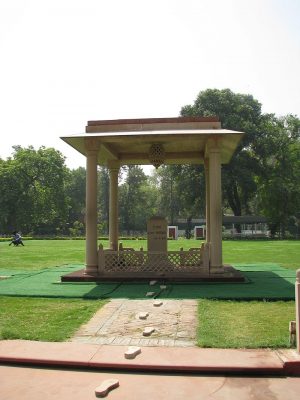On January 30, 1948, Mahatma Gandhi died of an assassin’s bullets. The gunman, 34-year-old Nathuram Godse, was a fanatic member of the Hindu Nationalist Party.
In 1945, talks for the independence of India began. Gandhi wanted India to remain unified, but the Muslim League pushed for the partitioning of the country. In 1947, after extended negotiations, Britain finally approved partitioning India into two independent states: India and Pakistan. Gandhi became very worried about the division of the country, and the partitioning was soon followed by the bloody conflict between Hindus and Muslims in India. To bring an end to the violence, Gandhi turned to fasting. Godse felt that Gandhi’s philosophy of nonviolence was why the Muslims gained a portion of India, leading to millions of people losing their homes and the subsequent violence and deaths. Godse believed that if nobody stopped Gandhi, thousands more Hindus would die. He thought that the only solution to the violence was to retaliate with violence. Godse was convinced Gandhi was betraying his Hindu brothers by sympathizing with Muslims. He said that Gandhi instructed only Hindus about the philosophy of nonviolence and not Muslims. And so, despite claiming that he did not hate Gandhi, Godse felt morally obligated to kill him.
At 5:00 p.m. on January 30, 1944, Gandhi walked slowly from Birla House to attend a prayer meeting. He was in a weakened state because of his fasting, and so he was helped along the way by his grandnieces while being watched by an admiring crowd. Godse appeared out of the crowd and bowed to Gandhi. Gandhi’s grandnieces thought he wanted to touch the old leader’s feet, but instead, Godse aimed his Beretta automatic pistol at Gandhi and shot him three times in the stomach. Surprisingly, Gandhi responded to Godse’s bow by lifting his hands to his face in the traditional Hindu greeting before collapsing to the ground. Some witnesses claim that they heard Gandhi call out, “Ram, Ram,” which in Hindu means, “God, God.” However, other witnesses say he just lay silently after collapsing. The first bullet from Godse’s pistol hit Gandhi a few inches above and slightly to the right of the navel. The second bullet hit him just an inch from the middle of his belly. The third bullet pierced the right side of Gandhi’s belly. Gandhi immediately lost a massive amount of blood. Everyone was shocked and confused, and somebody tried to call the hospital several times but failed to establish contact.
Some members of the crowd read passages from the Bhagavad Gita to the 78-year-old leader. After about 30 minutes, Gandhi died. News of Gandhi’s assassination had reached the prime minister, Jawaharlal Nehru, who eventually spoke over the radio and addressed the nation about the great leader’s death.
Gandhi seemed to have a premonition of his death about two weeks before he died. On January 13, Gandhi stated that he would welcome death rather than watch India be bathed in bloody conflicts between Hindus, Muslims, and Sikhs. He added that it was his dream for Muslims, Christians, Sikhs, and Hindus to live together in peace. Then, on January 20, just ten days before his death, Hindu extremists who were angered by Gandhi’s admonitions of peace hurled a bomb inside Birla House. It exploded just 25 yards away from Gandhi but left him unhurt. After the incident, Gandhi remarked that if an assassin killed him, he would die smiling with no anger in his heart and with God’s name on his lips.
The day after the assassination, a huge crowd of one million stood for five miles in anticipation of the funeral procession, which was expected to carry Gandhi’s corpse to the edge of the Jumna River. Gandhi’s corpse was clothed with the Indian flag and was transported by an army truck while airplanes scattered flowers from above. The chaos of the massive crowd caused the funeral to take five hours. When the funeral reached its destination, the police had to suppress the crowds to raise the bier onto the funeral pyre. While Gandhi’s remains were engulfed by flames, crowds threw flower petals on the pyre. Gandhi’s ashes were transferred into urns and transported to different places in India for memorial services. Some of his ashes were scattered at the Sangam at Allahabad in February 1948, but some were hidden away. In 1997, Mahatma Gandhi’s great-grandson, Tushar Gandhi, scattered a portion of Gandhi’s ashes onto the Ganges River. In 2008, another urn that contained Gandhi’s ashes was immersed in the waters of Girgaum Chowpatty beach.
Godse was executed by hanging on November 15, 1949, at Ambala Jail. It was reported that Godse did not die instantly of a broken neck but instead was choked by the rope for 15 minutes before he died.
